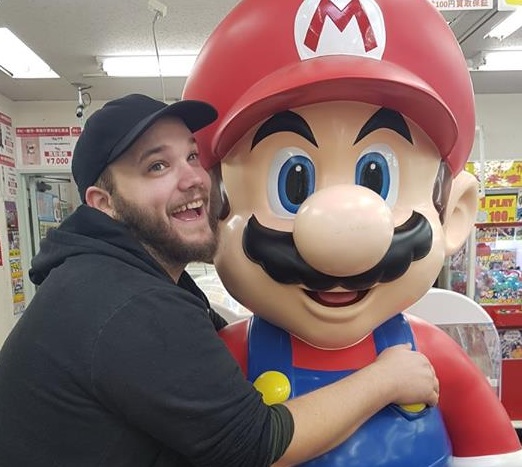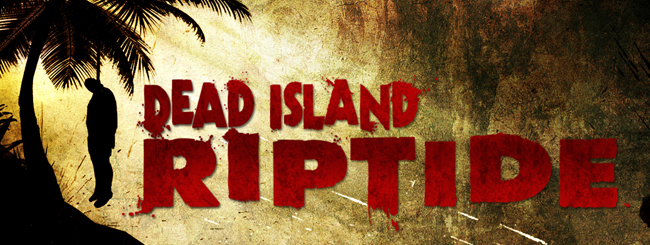
Riptide is the sequel to Techland’s 2011 title Dead Island, a hack and slasher fest that promised a lot more than it could deliver in the form of a trailer which would, in the end, turn out to be better than the game itself. It appears, though, that this apple hasn’t fallen far from the family tree as the clawing, biting, zombie hack’n’slash fest that Techland throws us into has a familiar sheen to it. Set on Palanai, a neighboring island to the first game’s Banoi, your group of survivors must fight their way through droves of relentlessly violent, undead monsters and perhaps uncover a few details about where it all started. Stop us if any of this is starting to sound familiar.
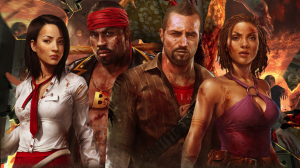
Choosing to unveil something a little more conservative for the new title, while somehow still managing to exclude any actual gameplay footage is probably one of the smartest decisions that the publisher made leading up to the launch of Dead Island: Riptide, because players would soon realise that around one hour into the experience, there’s hardly anything unique about this game to set it apart from its predecessor or to actually justify itself as a sequel. Well, except for maybe some mild controversy.
Dead Island: Riptide follows on from the events of the original “Dead Island” and tries to give those events more context by providing additional background information about how the plague broke out, which to me gives the impression that Techland regarded the story as being one of the more important aspects of the game. In the previous game and the DLC that continued the narrative, it was revealed that the convict who helped you escape was in fact a terrorist planning on using fellow survivor Yerema as a means of unleashing the plague on the rest of the world, and it created a neat segue into a possible sequel for the franchise. However, the introduction to Riptide undoes all of this during the first five minutes after it’s finished recapping the events of the first game.
After recounting their involvement, and introducing them in the initial cut scene, the game simply vanishes both characters to undisclosed locations and never mentions them again. This is a trend that continues throughout the game as the story introduces and knocks off characters without a great deal of context before hand, and with little regard for them afterwards. One example is Marvin, the ferryman, whose only purpose in the game is to appear exactly at the time you need him to ferry you across the sea before he becomes just another pointless member of your ragged group of survivors. You do get to perform side quests for the other survivors that you come across, which gives them some back story as to why they’re here and who they are, but it raises the issue about the game’s complete lack of characterization for the survivors you actually get to control.
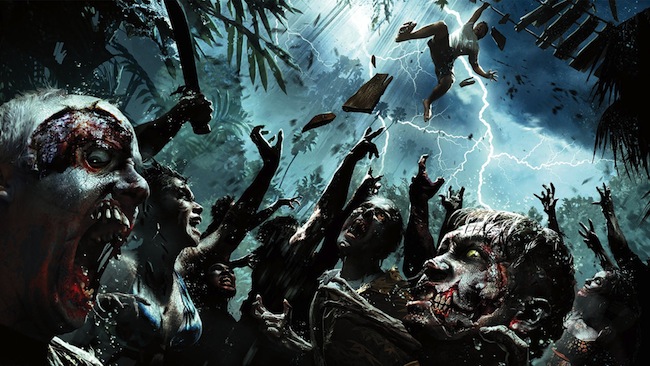
The dialogue for each character reflects this quite well as it’s been pretty tightly scripted across all five of them, with minor differences in word choice and usually in the form of how often they curse, with no regard to their various backgrounds and motives detailed at the beginning of the game. Even their attitudes towards the events that happen throughout the game are virtually identical, with all four of them rejecting or accepting what they’re told by other survivors without any kind of internal conflict, giving the impression that they’re all operating under some kind of hive mind that’s determined to sacrifice all character development for the sake of the plot.

Unfortunately, this still doesn’t allow the story to flourish in any meaningful way since the game carries a similar attitude throughout each of the different plot lines. For example, “Fury”, one of your character’s main abilities is a great example of this since the game tries to use it as a plot device to explain the degrading mental state of your character while it slowly consumes you. And yet, despite being a primary ability, it is also so unnecessary to the game’s combat that I only ever ended up using it twice when the script forced me to use it. However, each time this would happen a scripted dialogue would then run through a brief recap of what it was and why it was happening as if the story had just been created as an afterthought to justify any out-of-place core mechanics.
Riptide is either a solid action RPG or a poor survival horror, and it’s difficult to decide on which because the game can never make a concrete decision on what it wants to be. The combat system is certainly geared towards being action oriented, with modifiable weapons allowing you to tear through crowds of the undead with little effort, giving a visceral experience in zombie slaughter that you’d expect from an action title. However, the moment that your weapons stop being reliable, or the narrative drops you into an environment where visibility is low, suddenly it becomes a desperate struggle just to make it to the next repair station and this transition can be jarring.
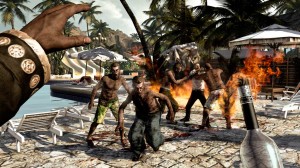
This also continues within other aspects of the game. For example, the environment provides plenty of weapon pickups and repair stations to keep the action going, and yet your character walks like a running washing machine with a brick inside as is typical of the survival horror genre and this can slow the action down. At different points the game will also force the player to choose between using scrap materials to modify their own weapons or to upgrade the weapons of their fellow survivors as a part of the many fetch quests that make up the bulk of the gameplay, but this choice isn’t nearly as significant as it sounds since you trip over various modification materials everywhere you go. It’s a prime example of genre confusion, and players will be required to consistently adjust their play style to progress. It’s simply poor design, and you can expect to get frustrated.
What will further disorient you, however, are the occasional glitches or bugs that crop up every so often, and in such insidious ways that you don’t even realise that’s what they are until you’ve already felt their effects several times under the guise of in-game design. During one of the main missions you’re tasked with finding a working boat in a ruined marina, which sounded easy enough at first but ended up taking me close to an hour to complete. I would eventually stumble onto a vacant patch of water that my character excitedly exclaimed was a damn fine looking boat. I couldn’t interact with this invisible boat in any way, except to place an engine on it which also disappeared, despite being told that I needed to use it to get to my next destination, which I then had to walk to anyway giving me ample time to ponder why the boat quest was even necessary.
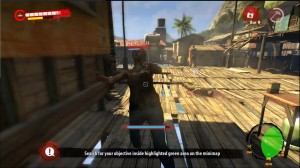
The most aggravating part about this is that the game makes you work for it, so that once you have it, you’ll feel a sense of accomplishment and really value this boat. However, once you reach the next part of the quest, eight other boats will instantly become available around the island and their exact locations will highlighted on your map througout the rest of the game. This is typical of anything that the game tries to create a sense of value for, with firearms probably being the best example; At the beginning of the game firearms are rare, as is ammunition, which creates the sense that they are precious and to be used sparingly. And yet, by the end of the game they are so common that you are able to use them to clear out most common enemy types, safe with the knowledge that ammo for each weapon type is lying in abundance within the immediate vicinity, wherever you are.
The combat is great, which is evident from the very beginning because when the conditions are right, and you’re in a position to do so, there is nothing more satisfying than carving off an infected’s arms, kicking it to the floor, stomping on it’s head, and then sliding, screaming, on the corpse into its buddies while flailing about a baseball bat with an electric saw blade strapped to it. Assuming you can master the fine art of managing the stamina to attack-and-movement ratio, you’ll have a fine old time wading through a sea of what were previously sort-of-living things before they met your Rob Zombie’d gym equipment. The fact that the combat is so entertaining is good because I can’t emphasise enough just how much you’ll have to get through to make progress.
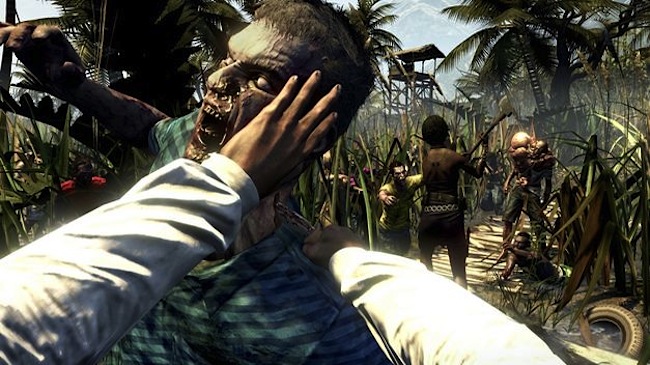
The only criticism that could be passed on the combat is the sense of urgency that it tries to create, but fails to deliver. The enemy AI appears to have been coded with several lines mandating fair play and honor, which are traits I had previously thought that the undead didn’t possess; After viciously knocking you to the ground they will politely stand around idly until you pick yourself back up, instead of swarming your vulnerable body like the many human buffets you find them feasting upon across the island. Even the threat of death doesn’t have any significant consequence as respawning only takes away a small amount of cash, which you pick up by the armful every time you find something even remotely container-like, before giving you all of your health back and placing you right next to where you died. While this is great for keeping the combat adrenaline pumping, it’s hard to feel like you’re in danger when you’re a walking god-machine of death.
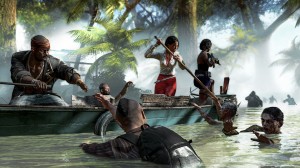
Every now and again you’ll come across a survivor stranded in the middle of the environment who’ll stop you to spit information in your face about what’s wrong with them, and unfortunately, these people will represent the majority of the side-quests outside of the main story missions. If they’re not in immediate danger of being torn apart by a group of the infected three times smaller than the one you just slashed your way through to get here, then it’s invariably some form of fetch quest along the lines of “Please, can you get me “x” item, the infected are too scary!”. The apparent uselessness of these people causes you to wonder how they even managed to make it this far in the first place, and the sheer repetitiveness of it will eventually put you off these quests altogether.
However, if you have any hope of a pain-free, fun experience during the main campaign, then the side quests are less of an ‘option’, and more like an ‘outright necessity’; The game scales the levels of the zombies it sends at you with your own progress, but over time it will introduce more of them until what was just a single special-type will become a veritable gaggle of psyched-out super-freaks who just can’t wait to wear your face. So when the game launches into it’s quest-chain ending horde mode at regular intervals during the story it won’t simply be a fun way to test out the new weapons and abilities that you’ve picked up along the way, it’ll also be a test of your patience toward the tedious fetch quests in the lead-up. Overall, the game seems to have an issue of spacing out the fun sections with grinding fetch-quests, which frustration will initially drive you away from before forcing you back in.
For all it’s faults, Dead Island does look very pretty, for a game filled with shambling corpses, and this might go a long way to explaining where most of the development time may have been spent. Having played it on the X360, it’s clear that they’ve taken advantage of what the console can do to create an environment that looks believable. The jungles, scattered holiday resort locations, and local residences lend themselves well to the dark atmosphere that they’re trying to set up in the first half of the game, with the ruined and quarantined city-scape from the second half of the game adding a sense of confused desperation while you navigate your way around the flooded, winding streets. The infected themselves are gruesomely designed and have done a great job of appearing vaguely human while still managing to substitute any human behavior for that of feral, and extremely hostile, animals, which gives a touch of authenticity that helps the player to suspend their disbelief.
This is diminished somewhat by the voice acting of the various characters in the game, all of whom sound incredibly bored instead of being terrified. The character you control rarely has much to say beyond the few cut scenes in the game, with most of the dialogue taking place when you accept quests, but since your character rarely says anything outside of a “Yeah!”, “No way!”, or “That’s f#$*@! up, Man!”, it feels as if you’re only a passive spectator to the main story and less of an active participant. The issues with the script aren’t limited to the characters you control, either as the bulk of the story is conveyed through the other survivors who can’t exactly be described as compelling, with one character casually informing you of an incoming nuke with all the passion of a depressed deaf-mute. It’s a serious immersion breaker, and honestly, it’s a little hard to take anyone seriously.
 Exciting, fast-paced combat
Exciting, fast-paced combat Beautiful environments
Beautiful environments Extensive weapon modding
Extensive weapon modding Under-developed story
Under-developed story Sub-par voice acting
Sub-par voice acting Mission breaking glitches
Mission breaking glitches Conflicting genre conventions
Conflicting genre conventions
If I had written a review for the original Dead Island, I could have simply chosen to follow their example by copying and pasting it, with only a few minor changes. The issues of the first game were forgivable to an extent, because it was the developer’s first foray into the IP and a whole new game concept in general; However, a sequel not only implies a continuation of the story, but a continuation of innovation and improvement within the series, which I could not honestly say is present here. With weak story telling, very little variation in environment or characters and a combat system that, while still incredibly enjoyable, is almost identical to the first game, the roughly eleven hour game time is probably the only thing that stopped this from being just a DLC add-on to the first game.

